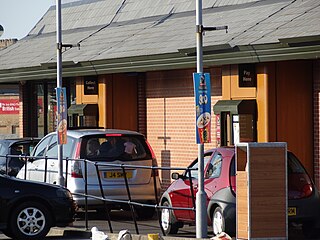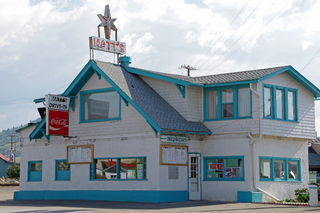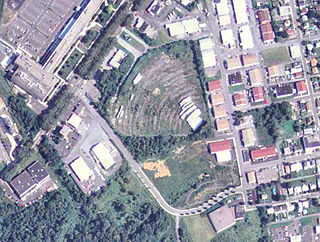
A movie theater, cinema, or cinema hall, also known as a movie house, picture house, picture theater or simply theater, is a business that contains auditoria for viewing films for public entertainment. Most are commercial operations catering to the general public, who attend by purchasing tickets.

Parking is the act of stopping and disengaging a vehicle and usually leaving it unoccupied. Parking on one or both sides of a road is often permitted, though sometimes with restrictions. Some buildings have parking facilities for use of the buildings' users. Countries and local governments have rules for design and use of parking spaces.

A diner is a type of restaurant found across the United States and Canada, as well as parts of Western Europe. Diners offer a wide range of foods, mostly American cuisine, a casual atmosphere, and, characteristically, a combination of booths served by a waitstaff and a long sit-down counter with direct service, in the smallest simply by a cook. Many diners have extended hours, and some along highways and areas with significant shift work stay open for 24 hours.

Sonic Corporation, founded as Sonic Drive-In and more commonly known as Sonic, is an American drive-in fast-food chain owned by Inspire Brands, the parent company of Arby's, Dunkin' Donuts and Buffalo Wild Wings. Sonic, founded by Troy N. Smith, Sr., opened its first location in 1953, under the name Top Hat Drive-In. Originally a walk-up root beer stand outside a log-cabin steakhouse selling soda, hamburgers, and hotdogs, Sonic currently has 3,545 locations in the United States. Sonic is known for its use of carhops on roller skates, and hosts an annual competition to determine the top skating carhop in the company. The company's core products include the "Chili Cheese Coney", "Sonic Cheeseburger Combo", "Sonic Blasts", "Master Shakes", and "Wacky Pack Kids Meals".

A drive-in theater or drive-in cinema is a form of cinema structure consisting of a large outdoor movie screen, a projection booth, a concession stand, and a large parking area for automobiles. Within this enclosed area, customers can view movies from the privacy and comfort of their cars. Some drive-ins have small playgrounds for children and a few picnic tables or benches.

The Varsity is a restaurant chain in Atlanta, Georgia. The main branch of the chain was the largest drive-in fast food restaurant in the world, taking up two city blocks and accommodating up to 800 diners. The main location ended car-side service in 2020. There are now six other branches across metropolitan Atlanta.

A truck stop, known as a service station in the United Kingdom, and a travel center by major chains in the United States, is a commercial facility which provides refueling, rest (parking), and often ready-made food and other services to motorists and truck drivers. Truck stops are usually located on or near a busy road.

A drive-through or drive-thru, is a type of take-out service provided by a business that allows customers to purchase products without leaving their cars. The format was pioneered in the United States in the 1930s, and has since spread to other countries.

A carhop is a waiter or waitress who brings fast food to people in their cars at drive-in restaurants. Carhops usually work on foot but sometimes use roller skates, as depicted in movies such as American Graffiti and television shows such as Happy Days. Carhops have long been associated with hot rods and 50s pop culture.

The Michigan Building is an office building and the former Michigan Theater in downtown Detroit, Michigan. It was constructed in 1925 and stands at 13 floors in height. The building contains a bar, restaurant, retail space, office space, a parking garage, and the shared coworking space Cowork at The Michigan.

Bob's Big Boy is a restaurant chain founded by Bob Wian in Southern California in 1936, originally named Bob's Pantry. It is now part of Big Boy Restaurant Group, the current primary trademark owner and franchisor of the Big Boy system. At its peak in 1989, there were over 240 Bob's locations throughout the United States, most belonging to Marriott. As of February 2024, the company operates 4 locations in California. Two of these restaurants are now protected historic landmarks: the Burbank location on Riverside Drive and the Downey location, previously known as Johnie's Broiler. In August 2020, plans were announced to open a Bob's Big Boy in Indian Springs, Nevada. The restaurant opened on November 8, 2020 as Big Boy without the Bob's branding, with future expansion planned across Southern Nevada.

Matt's Place Drive-In in Butte, Montana was one of the first drive-in restaurants in Montana. Unlike later drive-ins, which frequently featured a streamline moderne style, or at least an acknowledgement of their orientation to automobile-oriented customers, Matt's Place was a straightforward conversion of a house to serve customers in cars. Established in 1930, its chief concession to the automobile is a tall curb to keep parking cars from hitting the building and a menu on the outside of the building, advertising curb service. The interior retains its 1936 counter and 1950s lighting fixtures.

Delgadillo's Snow Cap Drive-In is a historic eatery and roadside attraction located along former Route 66 in Seligman, Arizona USA. The drive-in was built in 1953 by local resident Juan Delgadillo (1916–2004). Delgadillo was working on an extremely limited budget, so he built the restaurant mostly from scrap lumber obtained from the nearby Santa Fe Railway yard.
Kirby's Pig Stand was the first drive-in restaurant to open in the United States. It was opened by Jessie G. Kirby and Reuben Jackson in 1921, in Dallas, Texas. In the 1980s, it changed ownership to Jim Ingram and Monte Hough, and in 2009, its name was changed to Woodfire Kirby's.

1950s American automobile culture has had an enduring influence on the culture of the United States, as reflected in popular music, major trends from the 1950s and mainstream acceptance of the "hot rod" culture. The American manufacturing economy switched from producing war-related items to consumer goods at the end of World War II, and by the end of the 1950s, one in six working Americans were employed either directly or indirectly in the automotive industry. The United States became the world's largest manufacturer of automobiles, and Henry Ford's goal of 30 years earlier—that any man with a good job should be able to afford an automobile—was achieved. A new generation of service businesses focusing on customers with their automobiles came into being during the decade, including drive-through or drive-in restaurants and greatly increasing numbers of drive-in theaters (cinemas).

The Boulevard Drive-In Theater is a closed drive-in theater, located in Allentown, Pennsylvania. It was one of two drive-in theaters in Allentown; the second one was Cinema Treasures.

The Family Drive-In Theatre is an outdoor cinema located at 5890 Valley Pike one mile south of Stephens City, Virginia. The family-owned business opened in 1956 and is one of the state's few remaining drive-in theaters.

The Sci-Fi Dine-In Theater Restaurant is a theme restaurant at Disney's Hollywood Studios, one of the four main theme parks at Walt Disney World in Bay Lake, Florida, United States. Established in May 1991, the restaurant is modeled after a 1950s drive-in theater. Walt Disney Imagineering designed the booths to resemble convertibles of the period, and some servers act as carhops while wearing roller skates. While eating, guests watch a large projection screen displaying clips of 1950s and 1960s films as Frankenstein Meets the Space Monster, Plan 9 from Outer Space, and Attack of the 50 Foot Woman.




















